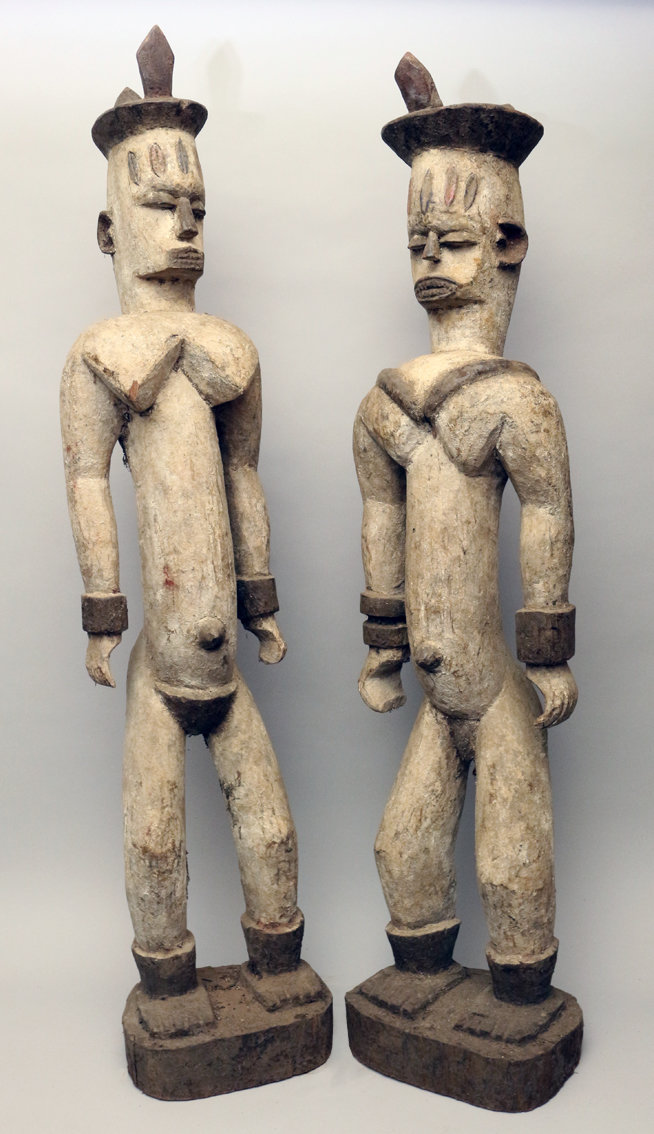Des pièces idéales pour commencer une collection qui vont de la pièce choisie pour son “coup de coeur” immédiat qui sera d’abord appréciée pour sa beauté à l’objet d’ethnologie choisi pour le sens dont il est porteur. Egalement dans cette rubrique des pièces dites de “remplacement” utilisées en Afrique pour remplacer une pièce détériorée ou abandonnée car destinée à n’être utilisée que par une seule ou même personne ou bien parce qu’elle a rempli ses offices.
Les pièces proposées ici sont aussi à des prix abordables afin de permettre à chacun de pouvoir commencer une véritable collection grâce à un budget limité.
-
Quick View€1,600.00
Ivory Coast, Baoulé mask
The Baoulés (Ba Ou li) are a people of Côte d’Ivoire, living mainly in the center of the country, near the cities of Bouaké and Yamoussoukro. They represent around 23% of the country’s population (around 3,943,667 individuals), which makes the Baoulés the first ethnic group in the country, ahead of the Betes and the Senoufos, who constitute the country’s second and third ethnic groups respectively. The Baoulés are part of the Akan group and are from neighboring Ghana. They settled in Ivory Coast in the 18th century, guided by Queen Abla Pokou. The name Baoulé comes from the sacrifice, by Queen Pokou, of one of her sons in order to cross a river, while she was leading the flight of her people from Ghana: ba ou li (the child is dead). The Baoulés settled between the Bandama and Comoé rivers.
***
Ivory Coast, Baule Mask
The Baoulés (Ba Ou li) are a people of Ivory Coast, living mainly in the center of the country, near the cities of Bouaké and Yamoussoukro. They represent about 23% of the population of the country (about 3,943,667 individuals) which makes Baoulés the first ethnic group of the country ahead of Betes and Senoufos which respectively constitute the second and third ethnic group of the country. The Baoulés are part of the Akan group and come from neighboring Ghana. They settled in Ivory Coast in the eighteenth century, guided by Queen Abla Pokou. The name Baoulé comes from the sacrifice, by queen Pokou, of one of her sons to cross a river, while she led the flight of her people from Ghana: ba or li (the child is dead). The Baoulés settled between the rivers Bandama and Comoé.
***
Elfenbeinküste, Baule-Maske
Die Baoulés (Ba Ou li) sind ein Volk der Elfenbeinküste, die hauptsächlich in der Mitte des Landes leben, in der Nähe der Städte Bouaké und Yamoussoukro. Sie repräsentieren etwa 23% der Bevölkerung des Landes (etwa 3 943 667 Personen), was Baoulés zur ersten ethnischen Gruppe des Landes vor Bêtes und Senoufos macht, die die zweite bzw. dritte ethnische Gruppe des Landes bilden. Die Baoulés gehören zur Akan-Gruppe und kommen aus dem benachbarten Ghana. Sie ließen sich im 18. Jahrhundert in der Elfenbeinküste unter der Führung von Königin Abla Pokou nieder. Der Name Baoulé kommt von der Opferung eines ihrer Söhne durch Königin Pokou, um einen Fluss zu überqueren, während sie die Flucht ihrer Leute aus Ghana führte: ba oder li (das Kind ist tot). Die Baoulés ließen sich zwischen den Flüssen Bandama und Comoé nieder.
-
Quick View€2,500.00
-
Quick View€3,100.00The Idoma are an ethnolinguistic group that mainly inhabits the western regions of Benue, Nigeria, and related groups are found in Cross Rivers State, Enugu State and Nasarawa State in Nigeria. The Idoma language is classified in the Akweya subgroup of the idomoid languages of the Volta family – Niger, which includes the Alago, Agatu, Etulo and Yala languages of the Benue, Nasarawa and Northern Cross states. The Akweya subgroup is closely linked to the Yatye-Akpa subgroup. Most of the territory is inland, south of the Benue River, some seventy-two kilometers east of its confluence with the Niger River. The Idomas are known to be classy “warriors” and “hunters”, but welcoming and peace-loving. Most of the land of Idoma remained largely unknown in the West until the 1920s, leaving much of the colorful traditional culture of Idoma intact. The population of Idoma is estimated at around 4 million. The Idoma people have a traditional chief called Och’Idoma who is the head of the Traditional Council of the region of Idoma while each community has its own traditional chief such as Ad’Ogbadibo d’Orokam, chief of Enenche. The palace of the Och’Idoma complex is located in Otukpo, in the state of Benue. The Idoma people have a traditional chief called Och’Idoma who is the head of the Traditional Council of the region of Idoma while each community has its own traditional chief such as Ad’Ogbadibo d’Orokam, chief of Enenche. The palace of the Och’Idoma complex is located in Otukpo, in the state of Benue. The Idoma people have a traditional chief called Och’Idoma who is the head of the Traditional Council of the region of Idoma while each community has its own traditional chief such as Ad’Ogbadibo d’Orokam, chief of Enenche. The palace of the Och’Idoma complex is located in Otukpo, in the state of Benue.
-
Quick View€1,100.00



